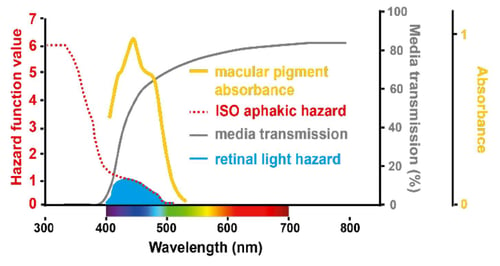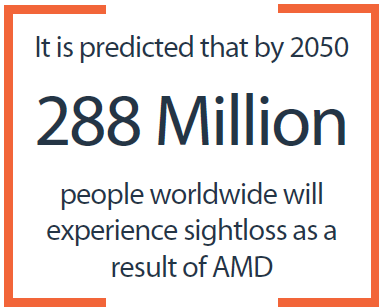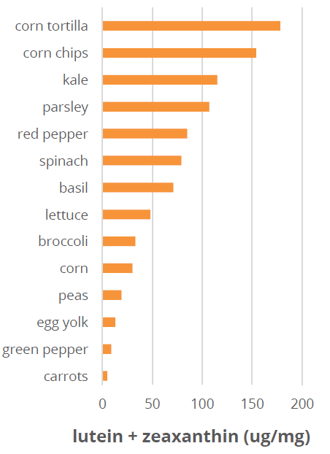Macular Pigments are your eye's natural protection against dangerous violet-blue light and oxidative damage, which contribute to advanced ageing of the retina [1]. We can only get our macular pigments from specific foods, so the amount of natural protection you have depends on your diet, and how well your body can assimilate them. Other lifestyle factors like smoking, obesity, light exposure and fitness also affect your macular pigment levels. The problem is that, just like blood pressure, you can't tell the state of your macular pigments without measuring them.
Over time oxidative damage to the retina accumulates, leading to the build of drusen - one of the first signs of Age-Related Macular Degeneration (AMD).
Macular pigments also improve vision by decreasing scatter, thereby reducing the effects of glare and increasing contrast sensitivity.

The MP-eye can assess how much macular pigment is in the eye in less than a minute.

What are Macular Pigments?
Xanthophyll Carotenoids
Macular pigments are long, thin molecules known as carotenoids, which you only get from your diet. Although there are as many as 50 different carotenoid pigments in our diet, only three – lutein, zeaxanthin and meso zeaxanthin – get concentrated in a thin layer in the macular region of the retina, just in front of the sensitive photoreceptors. These macular pigments act like natural sunglasses, protecting the retina from high-energy visible (HEV) violet-blue light, and also act as antioxidants neutralizing free radicals and reactive oxygen species. Colourful foods, such as peppers, kale, spinach, corn and eggs are particularly rich in macular pigments.
Everyone is Unique
Just as your skin pigmentation is unique to you, so is your macular pigmentation, and just like having lower skin pigmentation, and just like having lower skin pigmentation puts you at greater risk of UV damage leading to skin cancer, lower macular pigmentation puts your retina a greater risk from HEV photochemical damage leading to sight loss from AMD (Note: Macular pigmentation is not linked to skin colour, or hair or eye colour either). Genetics [2] is the main determinant of your macular pigmentation levels; it is your genes that determine how efficient your body is at acquiring the macular pigments from your diet., transporting them to the eye and incorporating them into the retina. Lifestyle choices such as a good diet [3], not smoking [4, 5], regular exercise, watching your weight [6, 7] and reducing exposure to violet-blue light [5] can all increase a person's macular pigment density over time. This means that your natural sunglasses are not only unique to you, but they can also change over time depending on who you are and what you do.
Macular Pigments and Eye Health
Natural Internal Sunglasses
Macular pigments preferentially absorb high-energy short-wavelength light [8] that is most damaging to the retina (380-500 nm, violet-blue). The macular pigments absorb as much as 90% of damaging HEV light before it hits the retina, protecting the retinal cells from damage. In addition to protecting the retina [9], the absorption of HEV light reduces blue light scatter in the eye, improving the signal to noise ratio. This improves contrast sensitivity [10], and reduces glare[11, 12], contributing to better visual performance.

Macular pigments absorb blue light precisely in the wavelength range of the retinal or blue light hazard defined by the International Organization for Standardization (ISO).
Antioxidants
Macular pigments, like all carotenoids, are some of the best antioxidants capable of neutralizing the harmful supercharged molecules that can cause damage to other molecules and cells [13, 14]. Macular pigments not only protect the retina by absorbing HEV light, but also help to counter the adverse effects of the photochemical reactions that happen when HEV light reaches the retina.

Low Pigmentation and AMD
There is considerable evidence to show that a low level of macular pigmentation is associated with an increased risk of AMD [15-17] - a disease that eventually leads to sight loss as a result of long-term damage to the retina. It has not been possible to prove a direct link between macular pigmentation and AMD as it would require a decades-long study. Even then, AMD is a complicated multi-factorial disease, making it difficult to control for different factors in order to isolate the cause. Yet, the correlation between the low macular pigmentation and AMD, together with the evidence for the protective role of macular pigments, makes for a convincing argument that maintaining macular pigmentation will support long-term eye health (reviewed in [18]).
Macular Pigmentation and Health
Recently there has been growing evidence that low macular pigmentation may also be indicative of diabetic retinopathy [19]. The role of carotenoids in cognitive function[20] and the correlation between low macular pigmentation and dementia and Alzheimer's disease are also active areas of research.

Left: Lutein and zeaxanthin content of foods that can help increase the eye's natural protection against blue light and oxidative damage.
Maintaining Macular Pigments
While there is nothing you can do about genetics, there are actions you can advise patients to take, that can improve their long-term eye health by increasing their macular pigment density:
- Eat a healthy and diverse diet
- Don't Smoke
- Maintain a healthy BMI
- Wear a hat
- Exercise regularly
- Wear sunglasses or photochromics
- Use blue-light-filtering lenses
Interested in learning more? Check out some of our related topics
References
- ISO, I.O.f.S., Ophthalmic optics-Spectacle lenses-Short wavelength visible solar radiation and the eye. 2018, ISO copyright office: Geneva. p. 34.
- Meyers, K.J., et al., Genetic determinants of macular pigments in women of the Carotenoids in Age-Related Eye Disease Study. Investigative Ophthalmology & Visual Science, 2013. 54(3): p. 2333-2345.
- Loughman, J., J.M. Nolan, and S. Beatty, Impact of dietary carotenoid deprivation on macular pigment and serum concentrations of lutein and zeaxanthin. British Journal of Nutrition, 2012. 108(11): p. 2102-2103.
- Hammond, B.R., B.R. Wooten, and D.M. Snodderly, Cigarette smoking and retinal carotenoids: Implications for age-related macular degeneration. Vision Research, 1996. 36(18): p. 3003-3009.
- Mellerio, J., et al., A portable instrument for measuring macular pigment with central fixation. Current Eye Research, 2002. 25(1): p. 37-47.
- Merle, B.M.J., et al., Plasma long-chain omega-3 polyunsaturated fatty acids and macular pigment in subjects with family history of age-related macular degeneration: the Limpia Study. Acta Ophthalmologica, 2017. 95(8): p. e763-e769.
- Kirby, M.L., et al., Changes in macular pigment optical density and serum concentrations of lutein and zeaxanthin in response to weight loss. British Journal of Nutrition, 2011. 105(7): p. 1036-1046.
- Snodderly, D.M., et al., The macular pigment 1. Absorbance spectra, localization, and discrimination from other yellow pigments in primate retinas. Investigative Ophthalmology & Visual Science, 1984. 25(6): p. 660-673.
- Wooten, B.R. and B.R. Hammond, Macular pigment: influences on visual acuity and visibility. Progress in Retinal and Eye Research, 2002. 21(2): p. 225-240.
- Loughman, J., et al., The relationship between macular pigment and visual performance. Vision Research, 2010. 50(13): p. 1249-1256.
- Putman, C.M. and C.J. Bassi, Macular pigment spatial distribution effects on glare disability. Journal of Optometry, 2015. 8: p. 258-265.
- Nolan, J.M., et al., Enrichment of macular pigment enhances contrast sensitivity in subjects free of retinal disease: Central Retinal Enrichment Supplementation Trials . Investigative Ophthalmology & Visual Science, 2016. 57(7): p. 3429-3439.
- Foote, C.S., Y.C. Chang, and R.W. Denny, Chemistry of singlet oxygen. 10. Carotenoid quenching parallels biological protection. Journal of the American Chemical Society, 1970. 92(17): p. 5216-&.
- Snodderly, D.M., Evidence for protection against age-related macular degeneration by carotenoids and antioxidant vitamins. Am Journal of Clinical Nutrition, 1995. 62(6): p. 1448-1461.
- Beatty, S., et al., Macular pigment and risk for age-related macular degeneration in subjects from a Northern European population. Investigative Ophthalmology & Visual Science, 2001. 42(2): p. 439-446.
- Bone, R.A., et al., Macular pigment in donor eyes with and without AMD: A case-control study. Investigative Ophthalmology & Visual Science, 2001. 42(1): p. 235-240.
- Bernstein, P.S., et al., Resonance Raman measurement of macular carotenoids in normal subjects and in age-related macular degeneration patients. Ophthalmology, 2002. 109(10): p. 1780-1787.
- Neelam, K., et al., Putative protective role of lutein and zeaxanthin in diabetic retinopathy. British Journal of Ophthalmology, 2017. 101(5): p. 551-558.
- Kelly, D., et al., Cognitive function and its relationship with macular pigment optical density and serum concentrations of its constituent carotenoids. Journal of Alzheimers Disease, 2015. 48(1): p. 261-277.
- Nolan, J.M., et al., Macular pigment, visual function, and macular disease among subjects with Alzheimer's disease: an exploratory study. Journal of Alzheimers Disease, 2014. 42(4): p. 1191-1202.
